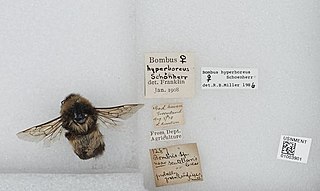
The glaucous gull is a large gull, the second-largest gull in the world. It breeds in Arctic regions of the Northern Hemisphere and winters south to shores of the Holarctic. The genus name is from Latin larus, which appears to have referred to a gull or other large seabird. The specific name hyperboreus is Latin for "northern" from the Ancient Greek Huperboreoi people from the far north "Glaucous" is from Latin glaucus and denotes the grey colour of the gull.
Glaucous is used to describe the pale grey or bluish-green appearance of the surfaces of some plants, as well as in the names of birds, such as the glaucous gull, glaucous-winged gull, glaucous macaw, and glaucous tanager.

Bombus hyperboreus is a species of Arctic bumblebee with a circumpolar distribution. The species is primarily found in the arctic areas of Greenland, northern Scandinavia, and Russia. In 2015 the nearctic species, Bombus natvigi, was separated from this species, based on genetic analysis. Accordingly, Bombus hyperboreus is limited to the Palaearctic, despite older literature listing this species as occurring in the Nearctic.
Antennoseius is a genus of mites in the family Ascidae.
Antennoseius bregetovae is a species of mite in the family Ascidae.
Antennoseius chirae is a species of mite in the family Ascidae.
Antennoseius garurensis is a species of mite in the family Ascidae.
Antennoseius janus is a species of mite in the family Ascidae.
Antennoseius koroljevae is a species of mite in the family Ascidae.
Antennoseius kurumanensis is a species of mite in the family Ascidae.
Antennoseius longipalpus is a species of mite in the family Ascidae.
Antennoseius makarovae is a species of mite in the family Ascidae.
Antennoseius matalini is a species of mite in the family Ascidae.
Antennoseius oudemansi is a species of mite in the family Ascidae. It is found in Europe.
Antennoseius ovaliscutalis is a species of mite in the family Ascidae.
Antennoseius ranikhetensis is a species of mite in the family Ascidae.
Antennoseius rugosus is a species of mite in the family Ascidae.
Antennoseius similis is a species of mite in the family Ascidae.
Antennoseius sinicus is a species of mite in the family Ascidae.

Angarichthys hyperboreus is an extinct homostiid arthrodire placoderm from the Middle Devonian of Siberia. It is known from an infragnathal plate, an intero-lateral plate, and a marginal plate found from the Middle Devonian strata of the Tynep Series formation, in the Bakhta River basin, Tunguska Plateau. A. hyperboreus differs from Homosteus in that the former's marginal plate has a ridge where the central plate would have overlapped it, and in the infragnathal, which is curved sigmoidally, and bears at least seven tooth-like prongs nearer to the functional anterior end.


